There’s an old English expression that goes “Wherever you may be, let your wind blow free!” Obviously there are limits to a literal interpretation of the rule (first dates, funerals, job interviews, and so on), but as a general rule for maximizing your own comfort and happiness in most situations, this one works pretty well. And it’s scientifically accurate too, because although we don’t normally think of the human body’s pressure equalizing functions as “wind”, that’s exactly what wind really is. To take the example of a burp, there’s more pressure inside our stomach than there is outside in the atmosphere, so we open a valve in our throat and the wind actually does “go free”, meaning it naturally moves from the high pressure area inside our stomach towards the lower pressure area outside without any further effort from us (beyond opening the valve). Nothing more is ever needed to create “wind” other than two different pressures of adjacent air masses, plus the possibility of flow between the two. The exact same principle is in effect when you equalize your ears underwater by opening the valve between your inner and outer ears. Same is true when you… well never mind, you get the point.
So what does this have to do with sailing? Well, everything actually. That’s because without these pressure equalizing principles, we’d still be stuck in the marina back in Marmaris wondering what the hell went wrong with our grand plan of sailing around the world. And as we now spend larger fractions of our lives benefiting from the wind pushing gently on our sails, and occasionally punishing us by ripping them apart, we have plenty of time to think about it, and more recently, study it. Understanding the wind, where it comes from, and how to anticipate it, is perhaps the biggest differentiator between inexperienced sailors like us, and the “masters” (in quotes because there is no such thing as a master in this discipline).
And after a day like yesterday, when an unforecasted circular storm came barreling towards us with just 12 hours notice, forcing us more than 50 miles off-course, we’re reminded about the importance of this aspect of sailing. To understand wind, you have to start with the concepts of pressure. When a pocket of high pressure (i.e. cold air) or low pressure (i.e. warm air) forms, the air will naturally flow outwards (high pressure) or inwards (low pressure) as the pressure equalizes between the pocket and its surrounding air mass – air always flows from high pressure towards low pressure. If you know the pressure differential between the low or high pressure pocket and the surrounding area, you also know the approximate pressure gradient between the two air masses. And if you know that, then you can easily forecast the rate of airflow (i.e. the wind speed). And this is why professional forecasters (or more modernly, computer models) and “master” sailors focus primarily on pockets of pressure (high or low), and particularly pressure gradients where the wind will inevitably be found. Complicating factors exist, such as when a high pressure and a low pressure pocket come close to each other, which exaggerates the pressure gradient (called a “squash zone”) and can lead to extreme conditions where the pressure gradient is steep (hurricane force winds, etc.). As you get further from the equator, you also encounter the “coreolis effect”, which is the effect of the earth’s rotation on air molecules, which creates predictable wind patterns, like the easterly trade winds in the tropics (our best friend), or the more violent “westerlies” nearer the poles (not recommended for novices).
The coreolis effect does something else: it makes big storms spin around their center. This is what made us so nervous when we checked our forecast two days after leaving Fiji, and found a brand new (unforecasted at the time we departed) 35 knot circular storm coming straight at us. 35 knots is probably nothing to worry about for those experienced with harsh weather (it takes 75 to reach hurricane force). But being new to this whole business of circular storms, we were a little freaked out to find one on our forecast (mainly because we’ve had 20 knot forecasts blow nearly 40 knots on us, so we’re accustomed to doubling the forecast as an estimate of possible gusts). So our immediate reaction was to head straight south, away from the storm’s center, set deep reefs in the main, roll up the jib, set the staysail, and prepare the cabin for World War III – almost certainly an overreaction (but not definitely). Most importantly, being the type of thing that could easily panic a Mom several thousand miles away (particularly one without expertise in circular storms or heavy weather sailing tactics) we embargoed the subject in our email traffic. At 2am, the cold front arrived on schedule – heavy rain along with rising wind. 15knots, 17, 19, then instantly up to 27, 32… And just as we wondered if it was going to shoot straight through 40, it stabilized. Luckily it did nothing more than our latest forecast had predicted (35 knots for about 20 minutes). At least that was the situation where we were in our more advantageous position south of the center – what was happening nearer the center we have no idea. In our hunkered down mode we now know we could handle much more than it threw at us… exactly how much we hope we’ll never find out. Once it passed, we turned back north towards Vanuatu, delayed but with a small bit of new valuable experience, and an additional reason to spend more time reading about the weather.
So Tarzan is now up on the bow whistling to dolphins (he know their calls somehow), and I’ve just heard Bro yelling “land ho!” from the cockpit, which means we’re finally approaching Vanuatu after our slow and disrupted passage. Ironically this is now happening as we motor in completely windless conditions. So we’re doing a wind dance, praying to the wind gods, and yelling to the world “let your wind go free!”, but we know that without a pressure gradient out there, our efforts are surely futile.
(For those interested in learning more about weather forecasting, we suggest Steve and Linda Dashew’s “Mariner’s Weather Handbook” – we also suggest everything else they ever wrote).
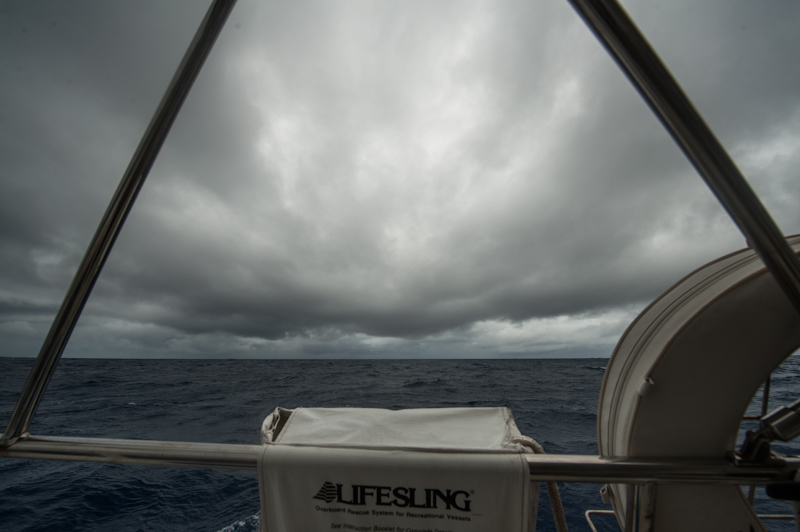
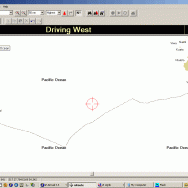
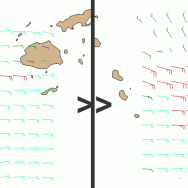
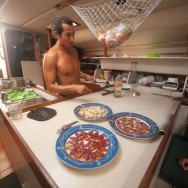
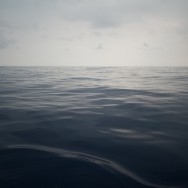
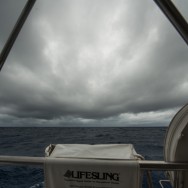
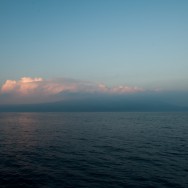
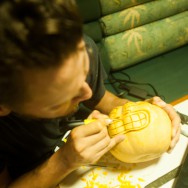
Actually, it’s an old Devonshire saying “where ‘er you be, let your wind blow free” (said in a broad Devonshire accent usually causes hysterical laughter from others 🙂 The words are written on the plinth of Sir Francis Drake’s Statue on Plymouth Hoe.
So relieved you managed to duck the worst of the storm.
Safe sailing.
Hi Jason and Piers Wave Riders
Fantastic to get your up date and to know you are in Tanna. Friends there are Werry Narua, who is in charge of the yacht club, Nelson and Lillian Nabua and Leha. Leha has a restaurant that does lunch down on the white sand beach – give them all my very very best wishes also to Johnson Ronnie and his wife and family. I think you will find there are several other people who I know so please give them all all my best wishes. Werry will help arrange transport as you will have to go to Lenakel to buy local currency, the Vatu. Vanuatu is expensive but I am sure you will find it very worthwhile. You must go up to see Mount Yasur – very satisfyingly terrifying!!!
Not sure where you will contact me from but my number is 0064-7-826-4646.Have a great time and enjoy Port Vila if you go for a visit to the capital.
Hope your voyage over to Aus will go well. OK guys great to catch up with you and hope you have enjoyed the pacific. Love to your parents and fare winds
Cheers Big Wave
It’s seldom that I feel compelled to comment on articles, but you’re material is content-worthy. Thank you for being so conscientious about what you write.